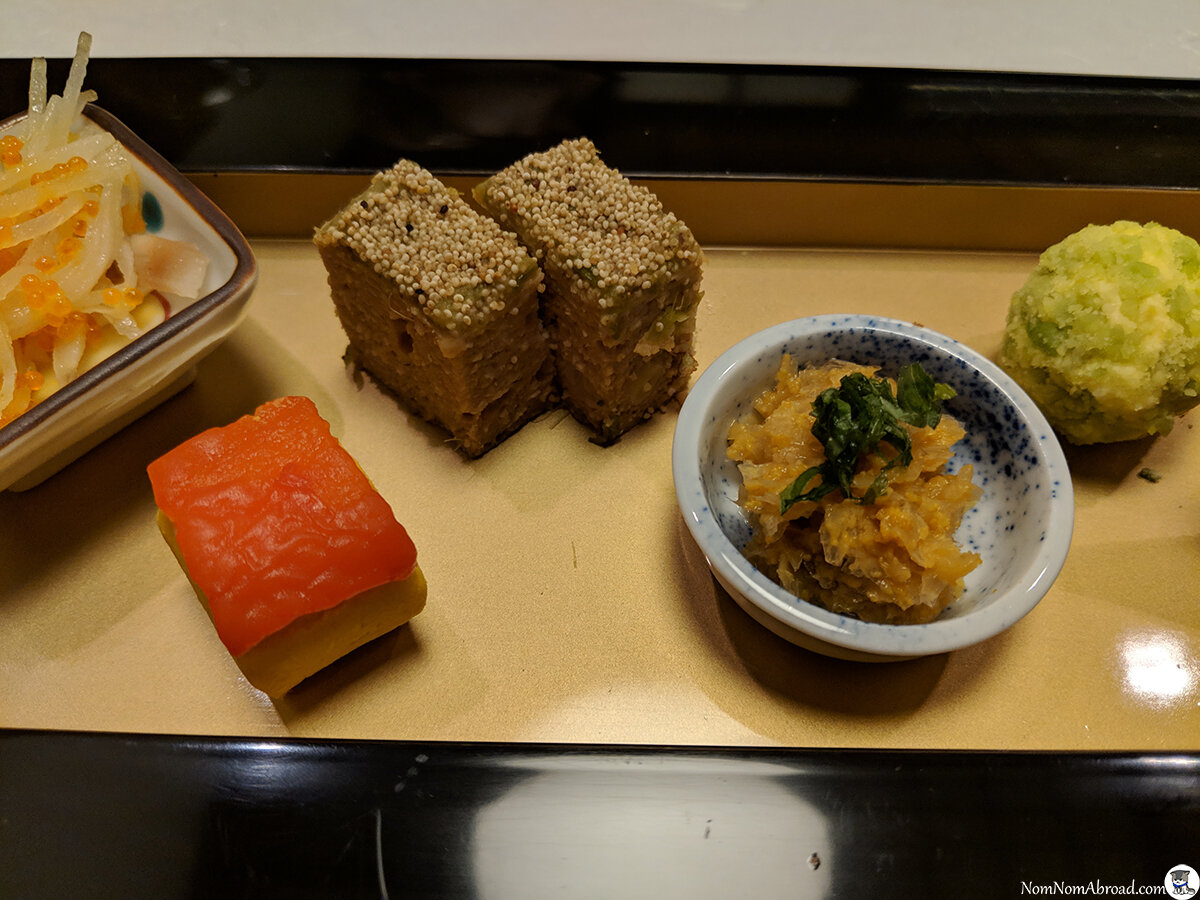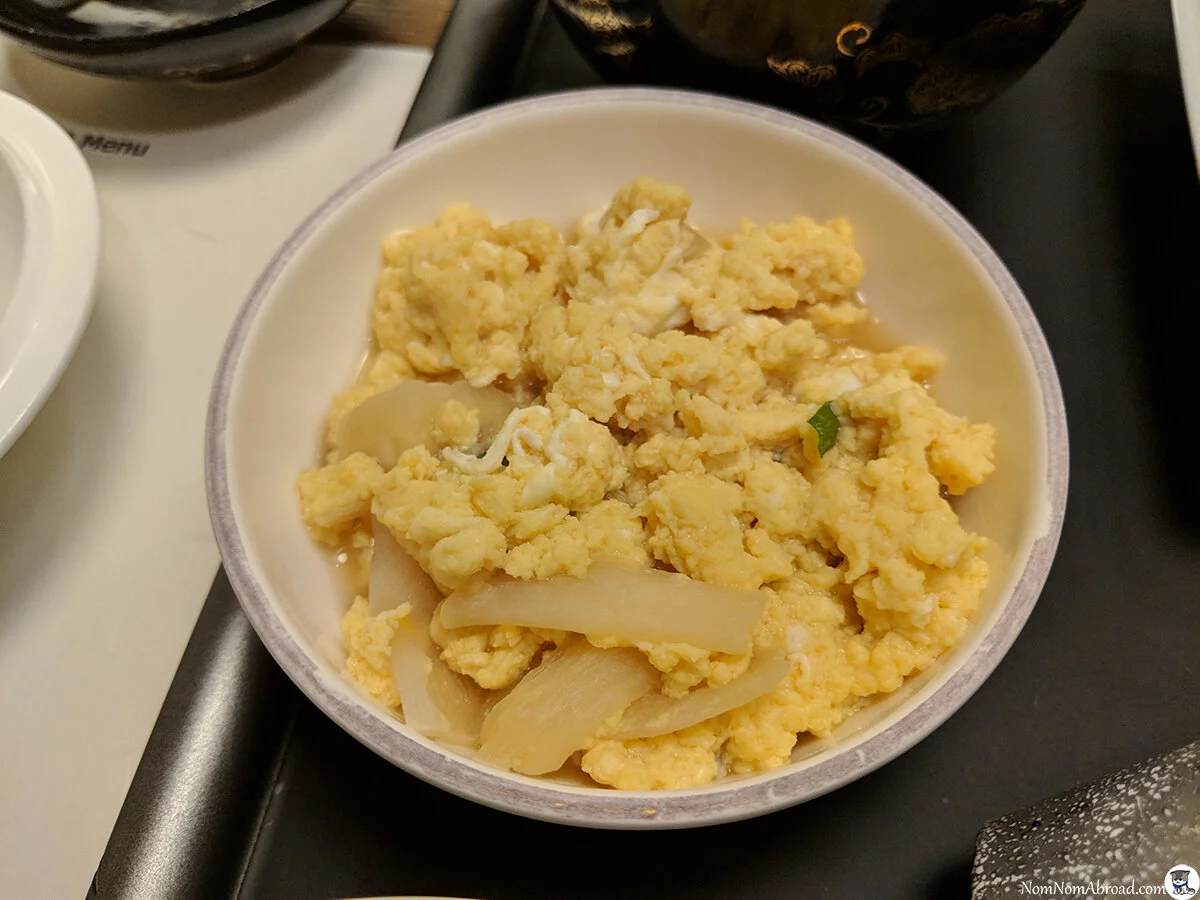Kai Nikko Kaiseki
/Our time at the Kai Nikko was fantastic, and one of the best parts of it, besides the amazing view from our room of Lake Chuzenji, was the food. As with other ryokans, Kai Nikko serves kaiseki meals for dinner. These meals usually offer seasonal and regional ingredients, and the regional specialty for Nikko is yuba. Yuba is tofu skin and was actually pretty good (although Michelle isn’t too crazy about tofu in general). Breakfast is a variation of a traditional Japanese breakfast.
During our two nights at the Kai Nikko we were fortunate enough to have two dinners and breakfasts. One of the things to appreciate, especially with kaiseki, is the presentation of the food. Each course was just as much of a meal for the eyes as it was for the stomach. The dishes that the food was served in would also sometimes take on regional aspects of the ryokan, like this porcelain box with the famous wise monkeys on it.
First Dinner
Our first dinner was a ten course meal. We started the meal off with an order of sake for Michelle and Asahi for Taylor.
The first course was the appetizer and consisted of the regional specialty yuba (tofu skin), jelly made of Japanese soup stock, and wasabi.
This was followed by the soup dish: Shin-jo cake made of pasted quail and fish, quail’s egg shaped as a persimmon, maple leaf shaped wheat gluten, edible chrysanthemum, and citrus.
Next was a dish of assorted delicacies. There are so many finely detailed pieces of food in this small porcelain box. In no particular order were boiled peanuts with mustard miso, a steamed wheat gluten cake made with Japanese mugwort and walnut miso, shrimp pickled in Chinese rice wine and salmon roe, grapes with tofu dressing, matsukaze-styled grilled chicken paste with raisins, ground Chinese yam soup and Japanese soup stock jelly made with wasabi, fried shiitake mushroom, and akane-age mushroom fried with paprika powder.
The sashimi course had the day’s specialty fish. This part came in a set of three stacked containers.
The vinegared dish had seasonal ingredients with dried bonito vinegar.
The grilled dish was salmon and matsutake mushrooms coated with egg and wrapped in fried vegetables.
After the grilled dish came the steamed course. This was steamed dumplings made of eggplant, shrimp, sea urchin, and chrysanthemum sauce.
The main dish consisted of Kai Nikko’s specialty of wagyu beef shabu shabu cooked in an oya stone box. This large covered stone box was carted in by our server. Steam was shooting out of the seam between the top and the lid. After a short cook time the wagyu was plated.
The rice course had white rice, miso soup, and pickled vegetables.
For dessert Taylor had yuba mousse with molasses jelly and freeze dried tofu. Michelle had the chestnut, molasses mousse, and apple compote.
Second Dinner
Our second dinner also had ten courses. The appetizer course came with steamed egg custard, starchy sauce, salmon roe, and sea urchin.
The next dish of assorted delicacies came with fresh fruits with mustard dressing mixed with rice malt. There was also grilled sillago, a shrimp and sesame rice cracker, cream cheese mixed with broad bean, sea urchin agar, grilled chicken paste with fukimiso (butterbur stalk mixed with miso), red green-pepper egg yolk served in the style of sushi, and stringed potato with flying fish roe.
Our soup course was thin noodles with sea bream in a naruto style broth.
The sashimi was again the ryokan’s daily fresh assorted seafood. The presentation of this particular gish was fantastic. The sashimi was laid out on a leaf on a bed of ice. It was done in a very intricate fashion and had a whole shrimp as the crowning center piece.
Then came the tempura course with a fried tuna ball. The fried trout and salmon ball next to it looked like it belonged in a coral reef. We were impressed with the complexity of this piece with all the fragile parts sticking out. The flavor was just as impressive as the appearance.
Next was the steamed dish of baked scallop dumplings in a starchy sauce.
The vinegar dish consisted of marinated fried Japanese sea perch.
The main dish was wagyu beef shabu shabu with Jimi soup.
Then came the rice dish with rice and egg porridge and pickled vegetables.
For dessert it was a variation of what we had had the night before. Michelle once again chose the chestnut, black honey mousse, and apple compote. Taylor had the yuba mousse on top of black honey jelly and freeze dried tofu.
The breakfast served each morning was a high-end version of a simple Japanese breakfast. Instead of each dish being served as different courses, we were served everything at once.
First Breakfast
Our first breakfast started out with a drink made from local yuzu fruit and came in a beautifully decorated glass. Breakfast usually doesn’t come in separate courses and instead is brought out all at once. With this breakfast we had a stewed dish with chicken meatloaf made with tofu, carrot, mushroom, radish, lotus root and okra. The egg dish was a thick Japanese omelet. Salt-grilled Spanish mackerel was the grilled dish. This meal came with a hot pot with soy milk with yuba, pork, and vegetables. This was accompanied by a meat-miso and kenjo sauce. We were given some delicacies made from soy milk tsukudani and kamaboko. All this came with white rice, miso soup, and Japanese pickles.
Second Breakfast
The second day’s breakfast had dried gourd strips mixed with eggs for the steamed dish. The stewed dish was a crab ball with radish and powdered shrimp in kuzu sauce. We weren’t expecting a small bowl filled with tiny shrimp. They were still delicious despite being so small. Trout was the grilled portion of the meal. The hot pot dish had boiled tofu and maitake mushrooms in tosa soy sauce. The standard white rice, miso soup, and Japanese pickles came with the meal as well. We also had some fruit as well.
One of the best parts of staying at a ryokan is the experience of having a kaiseki meal. It was always a lot of fun sitting down for dinner and not knowing what we’ll get. What we did know though, was it would be both delicious and a stunning display of the chef’s plating abilities. There are sometimes odd portions of these meals that use more unique ingredients that many westerners might find not so appealing, but that’s part of the experience. That odd dish could be amazing, and on many occasions we were slightly hesitant of something only to find out we loved it. That’s why we always recommend trying it out at least once when visiting!
Google Maps Link: Kai Nikko












































































